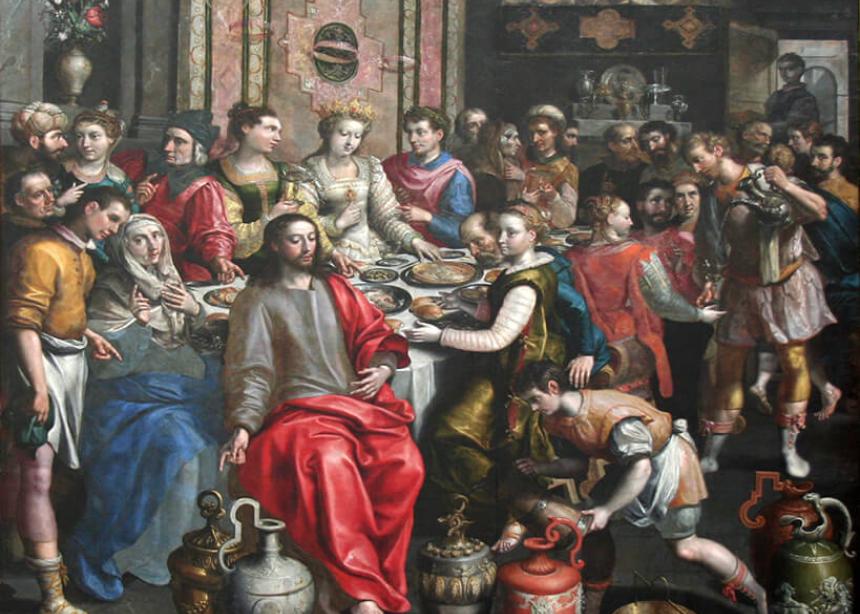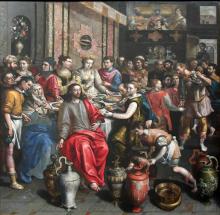In a time when western society is rapidly altering its image of marriage and government institutions have legally recognized same-sex marriage, the church is pressed to decide: Shall we follow suit?
The church is to discern between the fading form of this passing age and what is “good” and “acceptable” according to God’s will (Romans 12:2). Historically, the church has relied upon scriptural revelation, doctrinal tradition, rational wisdom and communal experience to guide discernment. In Article 4, our Confession of Faith in a Mennonite Perspective (1995) acknowledges Scripture as “authoritative source” for the church’s discernment, the “standard” against which all other claims must be “tested and corrected.”
Marriage and Scripture: Analogies to slaves and women
Some would argue that just as the church yesterday was wrong on slavery and women, so it is wrong on marriage today. The church today denying blessing to same-sex union for biblical reasons is akin to the church yesterday giving sanction to slavery and patriarchy for biblical reasons.
This argument requires careful scrutiny. Are the cases actually parallel? How should we evaluate the comparisons?
Concerning slaves and women, there are texts in the Old Testament that legalize and legitimate slavery or patriarchy, and even some texts in the New Testament that might be interpreted to reinforce oppressive or patriarchal practices. At the same time, there are textual strands running through the biblical canon that counter them, pointing the church toward overturning previous practices of oppression and patriarchy.
Regarding slaves, we can trace an arc of liberation from the Exodus narrative to Sabbath and Jubilee law (Leviticus 25; Deuteronomy 15), to prophetic critique (Isaiah 58; Jeremiah 34:8-22), to gospel proclamation (Luke 4:16-21), to apostolic teaching (1 Corinithians 7:21 and 12:13, Galatians 3:28; Ephesians 6:9; Colossians 3:11 and 4:1; 1 Timothy 1:8-11; Philemon 15-17). Cumulatively, this canonical arc points toward abolition of slavery.
Regarding women, we can trace an arc of Old Testament texts that teach “male and female” as made in God’s image and sharing “dominion” over creation (Genesis 1:26-28), texts that honour women leaders in Israel (Miriam, Deborah, Huldah and Judith), and texts that portray women as exemplars of covenant righteousness (Ruth and Naomi). This arc continues through New Testament texts that highlight women’s roles in Israel’s history (Matthew 1:1-16), that honour women’s participation in Jesus’ ministry and leadership in the early church (Mary, Martha, Joanna, Tabitha, Lydia, Prisca, Junia, Phoebe), that affirm unity of “male and female” in Christ (Galatians 3:28), and that call for mutuality between husbands and wives (1 Corinthians 7:3-5 and 11:11-12; Ephesians 5:21-33). Cumulatively, this canonical arc points toward egalitarian practices.
In each case, there are voices for slavery and patriarchy and counter-voices for liberation and equality in the biblical canon. Comparing the counter-voices to their canonical contexts and cultural backgrounds, and connecting them into a canonical arc, reveals a Spirit-guided redemptive movement that can guide the church’s discernment. We ask: How does that redemptive movement bear upon our situation? How can we act faithfully along that arc’s direction?
Taking the same approach in the case of marriage, we find that marriage practice throughout the biblical canon is neither simple nor static. While there are voices and counter-voices for mono/polygamy, for/against intermarriage and hierarchy/mutuality, the intra-canonical dynamic is constrained within the boundary of male-female union. The implicit norm across the biblical canon—evident in the origin narrative (Genesis 1:26-28 and 2:18-24); presumed in legal code (Leviticus 18), wisdom instruction (Proverbs 5-7) and pastoral counsel (1 Corinthians 7); apparent in poetic expression of erotic love (Song of Songs) and symbolic depiction of divine covenant (Isaiah 62:4-5; Hosea; Ephesians 5:22-32; Revelation 21-22)—is that marital union is predicated on the created difference and sexed correspondence of male-and-female.
Some today argue that the canonical pattern of male-female union is normal but not restrictive of marriage practice in the church. Such arguments reinterpret key texts in Genesis. Some argue that the story of “male and female” becoming “one flesh” is descriptive of cultural custom, but not prescriptive for marital union. Jesus, however, read the Genesis story as having prescriptive import with respect to marriage practice. That “from the beginning of creation” God “made them male and female” and joined them in “one flesh” (Genesis 1:27 and 2:24), Jesus interpreted, indicates God’s intention for marriage, according to which Jesus judged the human practice of marriage (Mark 10:6-9; Matthew 19:4-6).
Others argue that the biblical emphasis in marital union is on similarity, not difference: the man’s becoming “one flesh” with the woman signifies the man’s union with a creature like in kind to himself, not a human different in sex from himself. The Genesis text, however, equally emphasizes similarity and difference. The paired lines of poetic lyric highlight both human kinship (“This at last is bone of my bones and flesh of my flesh”) and sexed correspondence (“this one shall be called Woman, for out of Man this one was taken”) in becoming “one flesh” (Genesis 2:23).
Concerning same-sex practices, moreover, the biblical canon speaks with a single voice. The redemptive movement throughout the biblical canon is always away from same-sex practices. Even were disputed texts concerning same-sex practices discounted, there would be no positive voice in the biblical canon that counters the male-female pattern of marital union. No law permits or counsel commends or story favours same-sex union, unless one twists the text to turn David and Jonathan or Ruth and Naomi into erotic lovers.
Still, some people appeal to God’s working the divine purpose through marriages in non-normal ways—Abraham and Sarah or Mary and Joseph—as evidence that God would bless non-normative unions. Yet these instances themselves exhibit the normative pattern of male-female union.
Amidst diverse voices across the biblical canon, the marriage arc consistently evidences that marital union in the present age is predicated on the created order of male-and-female. Insofar as the church anticipates the coming age of renewed creation, the New Testament points beyond marrying-and-begetting toward celibacy, not same-sex union.
Therefore, the case of same-sex union is not analogous to the cases of slaves and women. While canonical arcs reveal redemptive movements pointing toward liberation of slaves and equality for women, no parallel arc points toward sanctioning same-sex union.
Marriage and membership: Analogy to gentiles
If the church is to discern an affirmation of same-sex union, then we must derive from the biblical canon a clear reason that compellingly warrants diverging from the canonical marriage arc. That reason must answer this question: Why should the church follow the counter directions of the liberationist and egalitarian arcs, but then diverge from the consistent direction of the marriage arc?
There are various texts throughout the biblical canon that augur for reception of Gentiles, Samaritans, eunuchs and others who were formerly considered “outsiders” to Israel as members-by-faith of God’s people. We can trace this canonical arc from the Exodus narrative (Exodus 12:38), to covenant code (Exodus 22:21 and 23:9), to holiness code (Leviticus 19:33-34), to festal law (Deuteronomy 16), to prophetic witness (Isaiah 56:3-8), to Jesus’ genealogy (Matthew 1:1-16), to Jesus’ ministry (Matthew 19:12; Luke 5:27-39 and 14:12-24; John 4:1-42), to early church (Matthew 28:18-20; Acts 1:8 and 8:4-40), to apostolic teaching (Galatians 3:27-28; Ephesians 2:11-22; Colossians 3:11; 1 Peter 2:9-10), to apocalyptic vision (Revelation 5:9-10). This inclusionary arc reveals a Spirit-guided redemptive movement that should shape a receptive posture in the church today toward various “outsiders,” including sexual minorities.
Some today invoke the inclusionary arc concerning marriage practice. Might “outsider” inclusion in membership be a precedent for same-sex inclusion in marriage? Might the church thus judge that the inclusionary arc supersedes the marriage arc? Some argue that the church today should redefine marriage as sex-undifferentiated to sanction same-sex union, in analogy to how the early church redefined membership as ethnicity-neutral to receive gentiles.
To redefine marriage in analogy to membership would blur the distinction between belonging (who is “in” and on what terms) and behaving (acting as befits belonging). That distinction in the church’s discernment is evidenced in a key text along the inclusionary arc.
At the Jerusalem council, the apostles and elders discerned that the church should receive gentiles on the same terms as Jews. Peter testified: “in giving [gentiles] the Holy Spirit . . . and in cleansing their hearts by faith [God] has made no distinction between [gentiles] and [Jews]” (Acts 15:8-9 and 10:34-35, 44-47). Nonetheless, the council made a distinction between gentile members, who were received on faith by grace (15:11), and certain practices from which believers were required to abstain (15:19-21).
Intended to facilitate gentile-Jew fellowship, these “requirements” were likely derived from holiness laws pertaining to aliens residing within Israel. Those laws forbade idolatry, eating blood or carrion, and various forms of illicit sex, including same-sex acts (Leviticus 17:8-18:30). Or these “requirements” possibly reflected teaching transmitted through the synagogue, which selectively adapted Mosaic Law to articulate a common ethic for Jewish life in Hellenistic culture.
The Jerusalem council reinforced canonical norms concerning sexual practice at the same time that it received gentiles as members. Marriage, therefore, is not analogous to membership. The Jerusalem council, in redrawing membership boundaries to include gentiles, did not redraw moral boundaries in any way that deviated from the canonical arc concerning marital union and sexual practice.
Marriage practice and church discernment
The apostolic decision at the Jerusalem council, which “seemed good to the Holy Spirit,” set an enduring precedent for the church’s discernment of what is “acceptable” to God. The council’s discernment worked along the inclusionary arc, but without letting membership inclusion override moral norms or redefine marital union. Therefore, for the church today to honour the canonical precedent of the Jerusalem council, we must hold both arcs together in our discernment.
Two important implications follow. The inclusionary arc is not optional for church practice, contrary to the inclinations of some traditionalists. At the same time, the inclusionary arc cannot be pitted against—or privileged over—the marriage arc, contrary to the claims of some innovationists.
This canonical-arc approach to biblical interpretation thus yields these questions to guide the church’s discernment:
- How do the marriage and inclusionary arcs together bear on our situation with respect to membership inclusion, marriage practice and sexual minorities?
- How might the church act faithfully along both arcs?
Let us prayerfully seek the instruction and guidance of the Holy Spirit (John 14:26 and 16:13) as we forbear patiently with one another in love and “the unity of the Spirit” (Ephesians 4:2-3).
Darrin W. Snyder Belousek is a lecturer in philosophy and religion at Ohio Northern University. He is the author of Atonement, Justice and Peace, published in 2011 by the William B. Eerdmans Publishing Co. He is a member of Salem Mennonite Church in Elida, Ohio. Originally published in a longer version in the January 2016 issue of The Mennonite.
See also “Marriage in embodied mystery”
For discussion
1. How much do our churches take their cues about what is right and wrong from the Bible and how much from the culture in which we live? Do we still give authority to the Bible in determining right and wrong?
2. Do you think biblical literacy and respect for the Bible is in decline in Mennonite churches? Why do we tend to question all authority more than earlier generations did? What do you say to those who believe the Christian church has completely lost its way?
3. Darrin Snyder Belousek describes an arc of biblical texts that deal with the liberation of slaves and the equality of women, but says there is no such arc for same-sex marriage. Do you find his argument persuasive? What would you like to say in response?
4. Snyder Belousek argues that the Jerusalem council was inclusionary but did not change the moral norms of the church. Do you agree? Where and how should the moral norms of the church be set today?
—By Barb Draper





Comments
This is another good Canadian Mennonite article on the controversy of the day. Snyder Belousek is thorough and thoughtful. I have just a couple of comments about his argument. He states that to see in the David and Jonathan story a positive eroticization of same-sex relationships is to "twist" the text. First, I encourage readers to re-read David's lament at the death of Jonathan and be honest about the impression such language creates in today's culture. Then consider that in the ancient world stories of male heroic friendships were regularly eroticized. This is seen in the friendships of Gilgamesh and Enkidu (this is the same epic which includes an account of the flood; there are fragments of the epic that are explicitly sexual), Achilles and Patroclus, Alexander and Hephaestion. That David's lament reflects a love going beyond male friendship is not certain, but it is a reasonable interpretation, in ancient times and today.
Snyder Belousek also makes use of the notion of story arcs and canonical arcs in his interpretation of scripture. That is fine, but identifying an "arc" in a complex narrative is like trying to draw a graph when you have only a few data points available. A number of plausible lines or arcs are possible, and they can look very different from each other. Here is one: the scriptures frequently take a very negative few of a wide variety of sexual activities, including heterosexual activity outside of marriage (eg adultery and religious prostitution). It also takes a negative view of homosexual activity. However, it never once considers homosexual activity within marriage. It would be continuation of that "arc" for the church of today to endorse same-sex marriage, and address homosexual activity outside of marriage in the same way it address heterosexual activity outside of marriage (now that is a can of worms!).
I'm not a Biblical scholar but I see the reasonable argument this article makes for the arc of slavery and women in the Scriptures. I also see how the church has further extended these arcs and how many congregations still have a long way to go to allow women to have full and equal places in our congregations.
I wonder if there's not a similar argument to be made for a movement from patriarchal marriage with multiple wives to our current committed and equal monogamous marriage model? Do we see strong examples of marriages in the Bible that model equal adult partners in a committed monogamous relationship? I think we start to see the basis for this in the New Testament but I also believe that the church has taken this basis much further in the past 2,000 years. Our last Mennonite Church Canada confession of faith defined marriage as "a covenant between one man and one woman for life." Is this found in the Biblical Canon or is this an extension of our faith, rooted in the Biblical story? There are certainly many Biblical stories that differ from the statement in our Confession of Faith. If the Confession is an extension of our faith, rooted in the Biblical story and discerned by thoughtful, faithful Mennonite Christians, then why is it such a stretch to replace "one man and one woman for life" with "two consenting, committed adults"?
God gives us grace, love and a guiding Spirit to discern God's will for us today. I believe that many thoughtful, faithful Mennonite Christians are hearing God's Spirit in a new way, allowing a further extension of our prior view of marriage. I'm not saying those who continue to hold to the view of the last Confession of Faith are wrong but is there not room for some trust in each other to allow for a new definition of Christian marriage? Many Mennonite Christians have long accepted that the "for life" part of the Confession's statement on marriage is not always possible and not always God's will, so let's be a little more open to how God's Spirit is leading some of our fellow believers to drop the gender restriction. May God continue to be with us as we all try to live out our faith today.
Add new comment
Canadian Mennonite invites comments and encourages constructive discussion about our content. Actual full names (first and last) are required. Comments are moderated and may be edited. They will not appear online until approved and will be posted during business hours. Some comments may be reproduced in print.